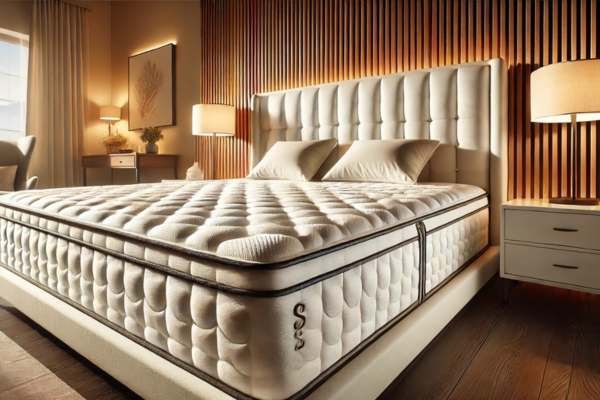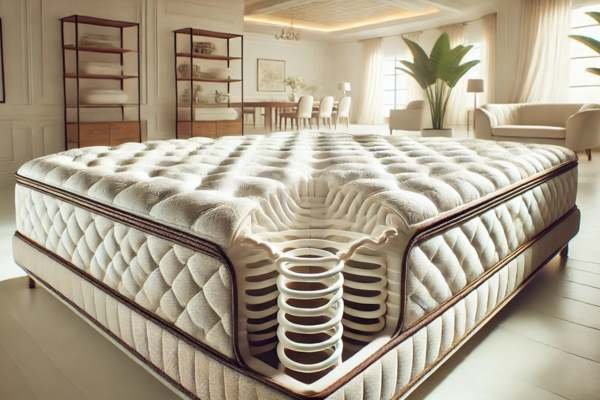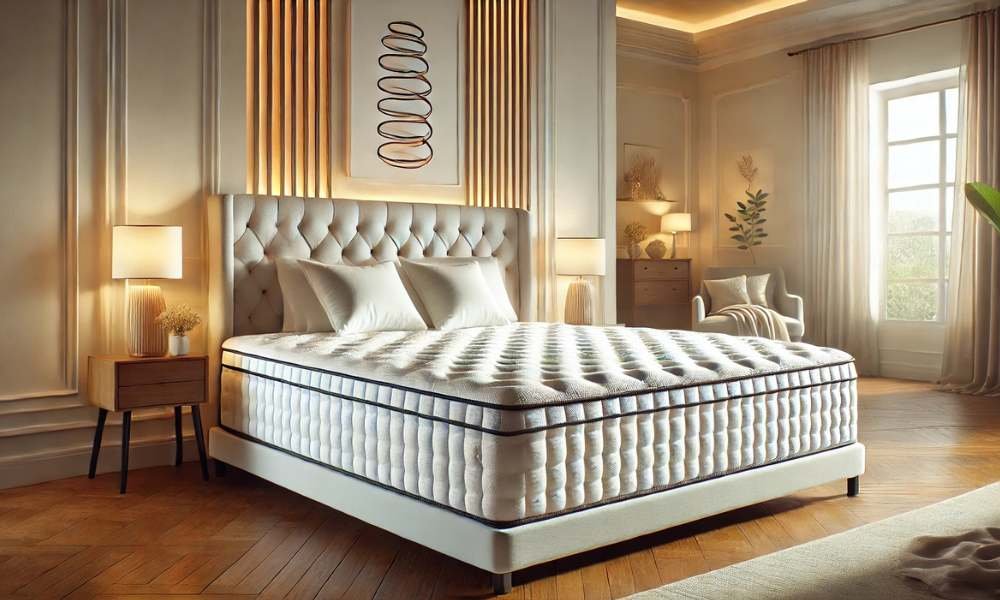An innerspring mattress is a classic bedding option known for its reliable support and timeless design. Built with a core of metal coils, this mattress type provides excellent weight distribution, pressure relief, and a responsive sleeping surface. Perfect for those seeking firm yet adaptable support, innerspring mattresses have evolved to include various coil technologies like Bonnell, pocketed, and offset coils, catering to diverse comfort needs. With added layers for cushioning and durability, they ensure long-lasting performance. Ideal for back and stomach sleepers, they also appeal to budget-conscious shoppers looking for quality sleep solutions. Whether you’re upgrading your bed or exploring options, understanding what an innerspring mattress is can help you make the best choice for restful nights.
Understanding The Basics Of An Innerspring Mattress

At the heart of every innerspring mattress lies a defining feature: the metal coil. These coils, either interconnected in a grid-like system or wrapped individually, form the supportive backbone of the mattress. They act as a responsive network, compressing under weight while springing back to distribute pressure evenly. Unlike their foam counterparts, innerspring mattresses provide a buoyant, almost weightless feel—an attribute cherished by those who prefer a firm yet flexible sleep surface. Despite modern innovations in mattress technology, the fundamental essence of the innerspring remains unchanged, standing as a symbol of dependability.
Types Of Coils In Innerspring Mattresses

Not all coils are identical, and their variations define the mattress’s performance.
- Bonnell Coils Originating from 19th-century buggy seats, these hourglass-shaped coils provide a balanced mix of firmness and flexibility. Though traditional, they remain a cost-effective choice.
- Pocketed Coils Encased in individual fabric sleeves, these coils excel at reducing motion transfer. Perfect for light sleepers or couples, they isolate movement, ensuring undisturbed rest.
- Offset Coils Engineered with a hinge-like design, offset coils contour to the body, offering enhanced support and durability—ideal for those seeking a mattress that adapts to their shape.
- Continuous Coils Crafted from a single wire, these coils prioritize stability and uniform support. Their interconnected structure makes them exceptionally durable.
Each coil type lends distinct characteristics, allowing consumers to choose a mattress tailored to their unique preferences.
The Structure Of An Innerspring Mattress

An innerspring mattress is an architectural marvel, composed of carefully layered materials.
- Support Core The foundation of the mattress, this layer houses the coil system, dictating firmness and responsiveness.
- Insulation Layer Sitting atop the coils, this layer prevents the upper materials from sinking into the core, preserving structural integrity.
- Comfort Layers Often crafted from foam, latex, or fibers, these layers provide a plush, cushioned feel, complementing the robust support below.
- Mattress Cover The exterior fabric encases the entire construction, offering both aesthetic appeal and protection against wear.
This layered design epitomizes the balance between support and comfort, a hallmark of the innerspring mattress.
Benefits Of An Innerspring Mattress

The enduring popularity of innerspring mattresses is rooted in their numerous advantages:
- Enhanced Airflow: The open coil structure allows air to circulate freely, preventing heat buildup.
- Cost Efficiency: Often more affordable than other mattress types, they provide excellent value for money.
- Longevity: High-quality materials ensure a lifespan of several years, with minimal sagging.
- Wide Range: With various designs and firmness levels, there’s an innerspring mattress for every sleeper.
How An Innerspring Mattress Supports Your Body

Support is the cornerstone of an inner pocket spring mattress functionality. By distributing frame weight calmly, the coils alleviate strain on joints and keep spinal alignment. For again and stomach sleepers, this prevents the body from sinking too deeply, preserving a impartial posture. The adaptability of pocketed coils in addition complements this assist, contouring to the body’s natural curves at the same time as reducing stress points.
Comparing Innerspring Mattresses To Other Mattress Types
Innerspring mattresses hold their own when juxtaposed with foam and hybrid alternatives:
- Innerspring vs. Foam: While foam mattresses cradle the body with their conforming properties, they often retain heat. Innerspring mattresses offer a cooler, more breathable experience.
- Innerspring vs. Hybrid: Hybrids merge foam and coils, blending comfort and support. However, their higher price tags make traditional innerspring models a more economical option.
Each mattress type caters to specific needs, but innerspring mattresses strike a harmonious balance between cost and functionality.
Choosing The Right Innerspring Mattress For Needs

Selecting the ideal innerspring mattress involves evaluating key factors:
- Firmness: Match the firmness to your sleep position and weight for optimal support.
- Coil Count: Higher coil counts often equate to better support and durability.
- Motion Isolation: Pocketed coils are ideal for minimizing movement disturbances.
- Budget: Balance cost with desired features to make an informed purchase.
Understanding Mattress Sizes
From compact twin sizes to expansive California kings, innerspring mattresses are available in dimensions to suit every need:
- Twin: Ideal for children or single sleepers with limited space.
- Full: Provides more room for single adults.
- Queen: A versatile option for couples or those who desire extra sleeping space.
- King: Spacious and luxurious, perfect for larger bedrooms.
- California King: Longer and narrower, catering to taller individuals.
Selecting the right size ensures both comfort and practicality.
Comfort Layers In An Innerspring Mattress

The comfort layers add a touch of luxury to the supportive core. Whether made from quilted foam, gel-infused materials, or natural fibers, these layers provide a soft, inviting surface. They complement the coil system, ensuring a restful experience that combines support with coziness.
Durability And Longevity Of Innerspring Mattresses
With proper care, an innerspring mattress can last up to a decade. Coil quality and construction methods play pivotal roles in determining longevity. Regular maintenance, such as flipping or rotating the mattresses, further extends its lifespan, ensuring consistent performance over the years.
Innerspring Mattress Maintenance And Care
To preserve your mattress:
- Rotate it periodically to prevent uneven wear.
- Invest in a mattresses protector to shield it from spills and allergens.
- Clean it regularly to maintain hygiene and freshness.
These steps ensure that your investment continues to provide unparalleled comfort and support.
Eco-Friendly Innerspring Mattresses
As sustainability becomes a priority, many brands now produce eco-friendly innerspring mattresses. Utilizing recycled steel for coils and organic materials for comfort layers, these options cater to environmentally conscious buyers who refuse to compromise on comfort.
Top Brands For Innerspring Mattresses
Leading manufacturers in the innerspring segment include:
- Sealy: Renowned for innovative designs and comfort.
- Serta: A trusted name in durability and affordability.
- Stearns & Foster: Synonymous with luxury and craftsmanship.
- Beautyrest: Famous for pocketed coil technology and superior motion isolation.
Exploring these brands can guide you to a mattress that suits your lifestyle and preferences.
Frequently Asked Questions
– What Is an Innerspring Mattress Made Of?
An innerspring mattresses consists of several layers:
- Support Core: Made up of metal coils (Bonnell, pocketed, offset, or continuous).
- Insulation Layer: Prevents the comfort layers from sinking into the coils.
- Comfort Layers: Crafted from materials like foam, latex, or fibers to enhance cushioning.
- Mattress Cover: Encases the entire structure, often made from fabric or quilted materials for added comfort.
– How Does an Innerspring Mattress Work?
Innerspring mattresses rely on a network of metal coils to provide support. When you lie down, the coils compress under your weight, evenly distributing pressure and responding to body contours. This design ensures proper spinal alignment, reduces pressure points, and delivers a buoyant, responsive sleeping surface.
– What Are the Benefits of an Innerspring Mattress?
- Breathability: Promotes airflow for a cooler sleep.
- Affordability: Often more budget-friendly.
- Durability: Long-lasting with proper care.
- Wide Variety: Available in numerous firmness levels and designs to suit different preferences.
– Who Should Use an Innerspring Mattress?
Innerspring mattresses are ideal for:
- Back and Stomach Sleepers: Firm support prevents sinking.
- Hot Sleepers: Enhanced airflow keeps the surface cool.
- Budget-Conscious Shoppers: Affordable without compromising on comfort.
- Couples: Pocketed coil options minimize motion transfer.
Final Thoughts
An innerspring mattress is a timeless choice in the bedding industry, offering exceptional support, breathability, and affordability. With its core made of durable metal coils, it provides a responsive surface that adapts to body contours, ensuring proper spinal alignment and pressure relief. Ideal for various sleepers, including back and stomach sleepers, it stands out for its cooling properties and diverse firmness options. Whether you’re seeking comfort, durability, or value, understanding what is an innerspring mattress can guide you to a sleep solution that blends tradition with modern innovation, delivering restful nights for years to come.

